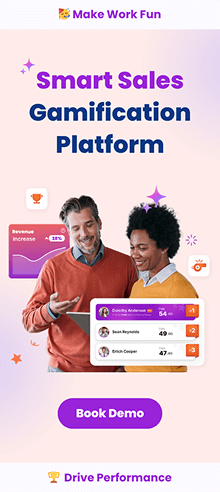Technology is constantly evolving. The many technological advancements are one of the many reasons traditional learning is outdated.
Students don’t just learn in school. They can learn from other sources, such as videos, games, blogs, etc. Textbooks and traditional classroom schooling lack depth, interest, engagement, and motivation.
Gamification takes on a different approach. It uses game elements to reinvent traditional learning methods, highlighting the benefits of gamification such as improved learning outcomes, increased engagement, and positive behavior change. It offers better learning outcomes, student engagement, understanding, and learning experience.
“Games and gamification both can lead to high levels of learner engagement and motivation.” – Karl Kapp.
Gamification is not just about playing games. It is about adding game elements to non-gaming settings. Some of these game mechanics include leaderboards, badges, and rewards. They provide measurable outcomes for the entire classroom.
Here is a quick overview of gamification vs. traditional learning.

What is Gamification in Education?
Gamification in education is the process of incorporating game elements and mechanics into the learning process to increase student engagement, motivation, and achievement. By integrating game design principles into educational activities, educators can create a more interactive and immersive learning experience. This approach makes learning more enjoyable and effective for students, whether in traditional classrooms or online learning environments.
In a gamified learning environment, students might earn points for completing assignments, receive badges for mastering skills, or see their progress on a leaderboard. These game elements transform the learning process into a dynamic and engaging experience, encouraging students to stay motivated and actively participate in their education. Gamification can be applied across various subjects and age groups, making it a versatile tool for enhancing both traditional and online learning.
Gamification as a Learning Strategy
- Gamification is a tool in education that adopts a holistic approach similar to online games.
- It incorporates gamification elements like design, progress tracking, and other game mechanics.
- These elements promote active learning, increase engagement, and boost intrinsic motivation through motivation gamification.
- While these components can be integrated into traditional learning, gamification focuses more on the experience than the score.
- In education, gamification provides learners with a sense of progression and a method to acquire information and knowledge.
- Recent reports indicate a 15.4% growth rate for serious games in higher education, particularly in business simulation games used in marketing, finance, and sales programs.
- The rise of gamification software has simplified its application in academics, offering versatility and convenience for a wide range of users.
- Due to the pandemic, 93% of American households with children have engaged in distance learning, highlighting the need for gamification to enhance the learning experience.
- Research shows that VR-based learning games have the highest growth rate (52%) compared to other educational game types through 2024, followed by assessment and evaluation games (46%) and language learning games (42%).
How are game elements different from gamification in education?
There are two ways to gamify the learning pathways: “gamification” and “game-based learning.”
Gamification adds game components to traditional instruction methods, creating a gamified environment. It is used to track the progress and performance of students on a much larger scale.
While game-based learning uses a more targeted approach, mainly focused on building a specific skill for achieving a particular task.
Gamification vs. game-based learning
Gamification:
- Applies game mechanics to non-game settings to encourage students in gamified learning environments
- Incorporates awards, achievements, badges, etc
- Gives students options to customize the learning experience
- Uses experience points instead of standard grades
Game-based learning:
- Uses games to accommodate learning outcomes
- Students learn from playing games.
- Uses education-oriented games
- Can include simulations to boost knowledge retention
Why is gamification useful in education?
Gamification is one of the must-have features of any learning management system. In education, challenge-based gamification leads to a 34.75% boost in student performance.
Students who received challenge-based gamification amplified their performance by up to 89.45% compared to those who only listened to lectures.
So, how is gamification different from traditional learning? For 67% of students, gamified learning resulted in increased student engagement and was more engaging and motivational than traditional learning. These are some critical advantages of gamification for upgrading the learning experience.

Gamification improves cognitive development and student achievement.
Research shows that digital games can shape the brain and behavior. They can change regions of the brain responsible for visuospatial and attention skills, making them more efficient.
Another 2022 research of 2,000 children showed similar results. Playing digital games for 3 hours daily helped enhance cognitive skills tests involving working memory and impulse control.
Games can engage different brain areas, such as the hippocampus, prefrontal cortex, and cerebellum.
Gamification and games offer a great deal of value because of context. Through gamification, learners earn points, compete with peers on leaderboards, and visualize their progress with the help of levels and scoreboards.
- Doing gamified lessons means learners put more mental energy into their work. Therefore, increasing their sense of belonging and ownership.
Khan Academy, for example, uses gamified learning software. Learners can use the app to practice math, history, computer programming, etc. This software allows students to obtain more knowledge and better problem-solving skills by strengthening two core motivators: rewards and feedback.
Learners earn experience points to get a badge, complete progress bars, and get verbal feedback. They also customize their avatar.
Gamification keeps students engaged
You can assess learners’ skills and interests based on their level of engagement.
But, in the classroom, only a few students like to stay active. They don’t see the importance and value of engaging in a classic schooling atmosphere.
With gamification and game-based learning, you can change that.
Game-based learning offers better motivation, engagement, and impact for students. It can increase student motivation by allowing learners to select topics that interest them and earn rewards like badges for demonstrating proficiency. That’s because students learn better when they use technology. Technology in learning offers a real-world context, which helps learners stay interested and motivated.
Gamification uses game-based elements, such as earning points to get rewards. Other game mechanics, like levels and badges, are also fun. They lead to increased engagement.
Competitive students can use their rewards to share their achievements with peers. This enhances student interaction and motivation, especially for learners honing a specific skill.
How is gamification different from traditional learning?
There is a significant difference between gamification vs. traditional learning.
- Traditional education forces students to learn material that often isn’t relevant or entertaining. With gamification, students can customize their learning experience, which enhances creativity, innovation, and student motivation.
- Traditional learning uses grading to assess students’ competency, knowledge, and skill. Gamification uses experience points. Experience points are gained over time and can be obtained in different ways. This allows students to improve their learning and address multiple shortcomings.
- Traditional learning uses textbooks and lectures. This is another notable difference between gamification vs. traditional learning. Traditional methods need to integrate with technology fully. They are monotonous and boring and don’t provide any engagement. Game-based learning and gamification use 21st-century learning methods. A gamified system offers reliable results, helps assess the student’s learning capacity, and enhances collaboration, skill development, and problem-solving. It also makes practical classes exciting and enjoyable.
- Traditional learning requires students to learn in a specific timeframe. With game-based learning or gamification, students can learn at their own pace. Game-based learning uses education-oriented games, while gamification applies game elements to non-game settings. This can significantly impact students who need more time to learn a specific concept.
Gamification Mechanics
Gamification mechanics are the specific elements and techniques used to create a gamified learning environment. These mechanics include points, badges, leaderboards, challenges, and rewards, all designed to foster a sense of engagement and motivation among students. By incorporating these elements, educators can create a learning experience that encourages students to participate actively and strive for continuous improvement.
Key Elements of Gamified Learning
Creating an effective gamified learning environment involves several key elements:
- Clear Goals and Objectives: Students need to understand what they are working towards and what they need to achieve. Clear goals provide direction and purpose.
- Feedback and Assessment: Regular feedback and assessment help students stay motivated and track their progress. This can include verbal feedback, progress bars, and scoreboards.
- Choice and Autonomy: Allowing students to make choices and have control over their learning process increases engagement and motivation.
- Social Interaction: Interaction with peers and teachers is crucial for maintaining engagement and motivation. Collaborative activities and peer competition can enhance the learning experience.
- Fun and Enjoyment: Learning should be enjoyable. Incorporating fun elements keeps students interested and eager to learn.
The Role of Game Elements in Learning
Game elements are the building blocks of a gamified learning environment. They provide the structure and incentives that drive student engagement and motivation. Key game elements include:
- Points and Badges: These elements provide a sense of achievement and progress. Students earn points for completing tasks and badges for reaching milestones.
- Leaderboards: Leaderboards introduce a competitive element, motivating students to improve their performance and climb the rankings.
- Challenges: Challenges offer opportunities for students to test their skills and knowledge, providing a sense of accomplishment when they succeed.
- Rewards: Rewards, whether tangible or intangible, provide satisfaction and motivation for students to continue their efforts.
How to use gamification in education?
The main focus of gamification is to broaden knowledge and enhance work habits. Gamification mechanics are there to support these habits. The point system helps teachers monitor their students and see how far they’ve come.
How can you add gamification to a classroom? You can introduce game-like elements in your classroom. You should apply the features that make games fun, immersive and engaging to the learning activities to keep students engaged.
Gamification features can include things like:
- Rewards or badges – Learners can obtain rewards for completing specific tasks related to their education. These rewards shouldn’t be too easy to get. Otherwise, gamification won’t have a real impact. They need the right complexity and achievability to make them appealing and rewarding.
- Experience points (XP) – In any game, XP measures how well the user has mastered the environment. More points mean better scores. But, to make this feature engaging, it must be cumulative and challenging. For example, overcoming difficult obstacles should earn students more XP. Simpler tasks give less XP. This helps students understand the difficulty level associated with every task.
- Levels – Levels and XP are often interconnected. Each level has a specific XP target range. Once the student hits the XP target, they level up. You can set different target levels every semester for marking student progress.
Examples of gamified learning environments in eLearning
To create gamified eLearning, you can’t create a full-blown game. You need to incorporate a couple of elements into your learning practice and use them to upgrade the standard learning methods.
Here are a couple of examples of using gamification in eLearning.
- Competitions – Gamification allows students to compete and reach for the highest score. They can outperform their peers and achieve better rewards.
- Visual design – With gamification, you can create pleasing designs to help students visualize their learning process. Anything visually stimulating can help enhance engagement and focus.
- Feedback – Tests and essays alone are insufficient to give teachers a better perspective of students’ capabilities and skills. Gamification offers consistent feedback with each task or quiz. This can help keep track of the progress in various stages of the learning experience.
Implementing Gamification in the Classroom
Implementing gamification in the classroom can be a straightforward process with careful planning and execution. Here are some steps to follow:
- Identify the Learning Objectives: Determine what you want students to learn and achieve. Clear objectives guide the design of the gamified activities.
- Choose the Game Elements: Select the game elements that will best support the learning objectives. Consider points, badges, leaderboards, challenges, and rewards.
- Design the Game: Create a clear and engaging game design that incorporates the chosen game elements. Ensure the design aligns with the learning objectives and is accessible to all students.
- Test and Refine: Test the game with a small group of students and gather feedback. Use this feedback to refine the game design and address any issues.
- Implement the Game: Roll out the game in the classroom and monitor student progress. Make adjustments as needed to ensure the game remains engaging and effective.
By following these steps, teachers can create a gamified learning environment that engages and motivates students, leading to increased student achievement and critical thinking. Gamified learning programs can transform the educational experience, making it more dynamic, interactive, and enjoyable for students.
Spinify can help
Gamification in learning has many advantages, both for students and teachers. It is here to gamify the educational experience and create new outcomes. Students can use gamification to absorb more information and gain adequate feedback.
Many things set gamification vs. traditional learning apart. First, traditional learning is outdated and doesn’t integrate with 21st-century technology. Gamification is a simple tool that can change that and offer continuous learning. If you are looking to gamify your educational institution or business, Spinify can help. Our team is a leader in sales gamification. We can help you leverage innate human psychology, engage, and motivate students through gamification. Book a demo today to get started.





